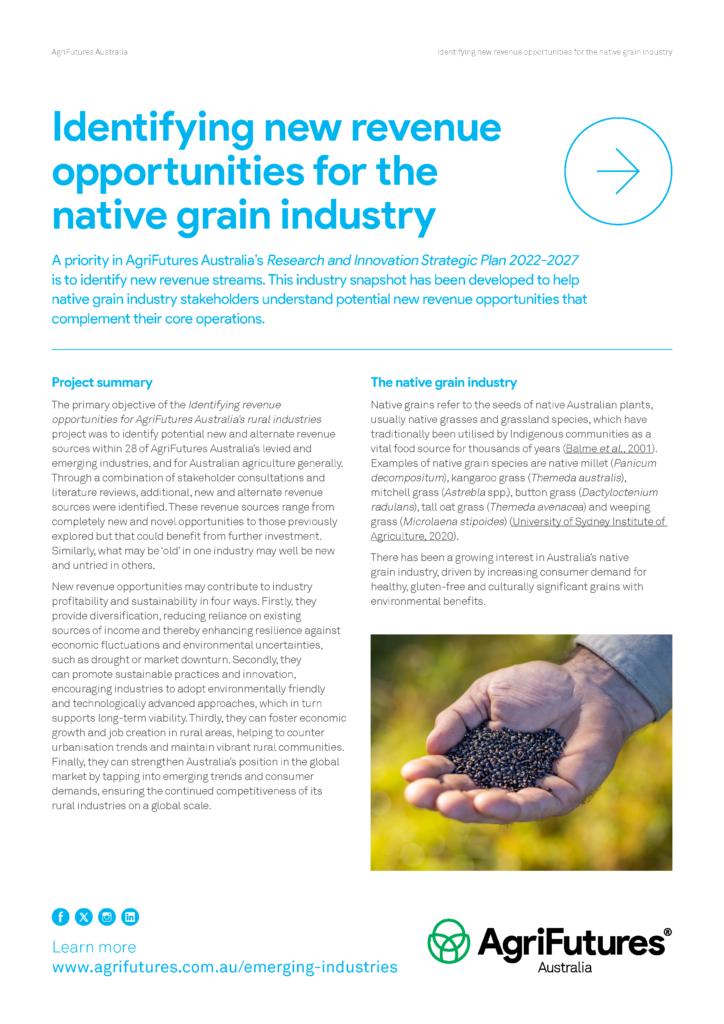Industry placemat: Truffles
This placemat serves as a resource for those interested in the emerging Australian-truffle industry. Within this placemat, you’ll find essential fast facts alongside the fundamental...

2 pages
Published: 11 Oct 2024
Author(s): AgriFutures Australia
Download report PDF
DownloadThe primary objective of the Identifying revenue opportunities for AgriFutures Australia’s rural industries project was to identify potential new and alternate revenue sources within 28 of AgriFutures Australia’s levied and emerging industries, and for Australian agriculture generally. Through a combination of stakeholder consultations and literature reviews, additional, new and alternate revenue sources were identified. These revenue sources range from completely new and novel opportunities to those previously explored but that could benefit from further investment. Similarly, what may be ‘old’ in one industry may well be new and untried in others.
New revenue opportunities may contribute to industry profitability and sustainability in four ways. Firstly, they provide diversification, reducing reliance on existing sources of income and thereby enhancing resilience against economic fluctuations and environmental uncertainties, such as drought or market downturn. Secondly, they can promote sustainable practices and innovation, encouraging industries to adopt environmentally friendly and technologically advanced approaches, which in turn supports long-term viability. Thirdly, they can foster economic growth and job creation in rural areas, helping to counter urbanisation trends and maintain vibrant rural communities. Finally, they can strengthen Australia’s position in the global market by tapping into emerging trends and consumer demands, ensuring the continued competitiveness of its rural industries on a global scale.
Industry-specific challenges
Specific insights relating to the Australian native grain industry include:
1. There is minimal Indigenous representation – currently about 1% – in the supply chain. The risk of exploitation or misappropriation by both domestic and international entities of cultural knowledge of native grains is an escalating issue, and there are concerns relating to land rights.
2. There is limited native grains research and knowledge, and a lack of specialised infrastructure. Equipment, processing facilities and business models are primarily tailored for commercial grains.
3. Poorly functioning and fragmented native grains markets are characterised by a lack of market awareness, inconsistent demand, erratic supply, poor seed quality and limited information flow.
Industry-specific opportunities
Specific opportunities relating to the Australian native grain industry include:
1. Differentiating native grains from conventional grains to increase their perceived value among health-conscious consumers. Generally, native grains contain higher levels of nutrients desirable for both good health and to prevent nutritional diseases. Additionally, using native grains as key ingredients in native products can enhance their appeal as superfoods.
2. Collaborating and partnering with Indigenous communities to establish fair benefit-sharing frameworks and intellectual property arrangements to value and share Indigenous community knowledge in alignment with both domestic and international market aspirations. Fostering stronger relationships, building trust and honouring and respecting the cultural significance of native grains will help facilitate industry growth and success.
3. Producing native seeds for a sustainable environment – the sale of grass seeds to the revegetation and rehabilitation markets is a promising revenue opportunity. Participating in carbon credits or biodiversity credit programs and utilising native grass species in the management of natural ecosystems will also provide additional revenue and help to build sustainable environments.